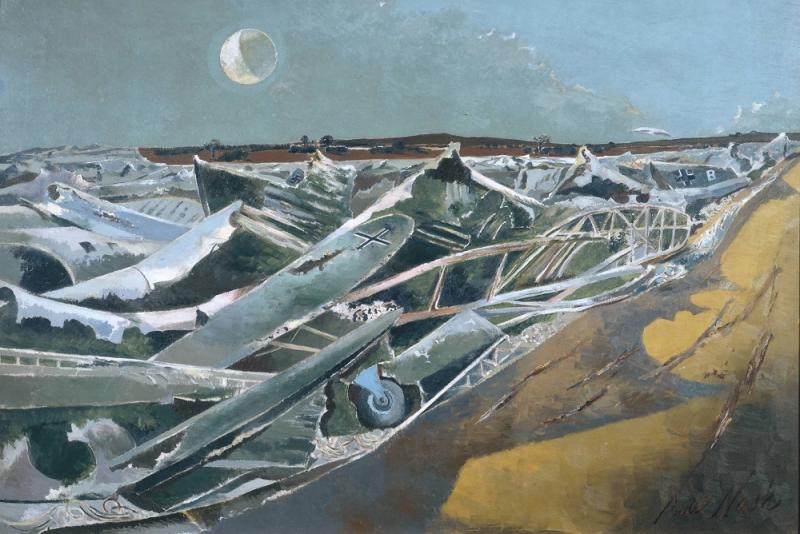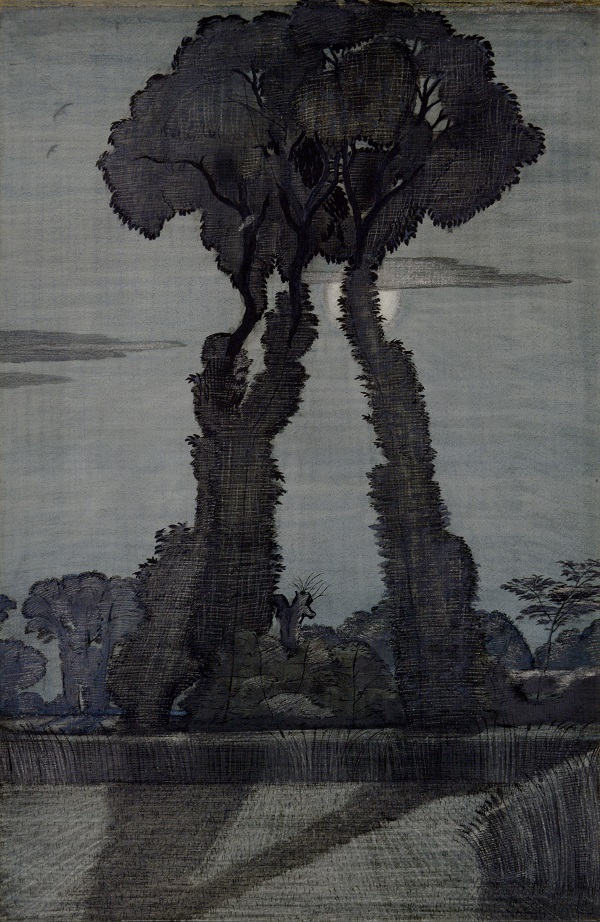Paul Nash, Tate Britain | reviews, news & interviews
Paul Nash, Tate Britain
Paul Nash, Tate Britain
Key themes recur, but the visionary landscape painter experimented constantly

In Monster Field, 1938, fallen trees appear like the fossilised remains of giant creatures from prehistory. With great horse-like heads, and branches like a tangle of tentacles and legs, Paul Nash’s series of paintings and photographs serve as documents, bearing witness to the malevolent lifeforce that, unleashed by their undignified end, has taken hold of these apparently dead trees.
Like the trees of Monster Field, piles of wrecked World War Two aircraft at Cowley Dump, removed from their proper environment in the sky, take on a new and disturbing life of their own, shifting and stirring, transformed into a sea of metal in Totes Meer (Dead Sea), 1940-1 (main picture).
 With its formal and thematic links to the earlier painting, Winter Sea, 1925-37, Totes Meer demonstrates Nash’s preoccupation with metamorphosis and the hostile encroachment of the sea, themes that recur throughout his career. For an artist whose output extends far beyond the fine paintings of World War One and exceeds the parameters of British landscape painting within which his work is usually understood, the recurrence of certain themes and preoccupations – a sense of significant place, and the idea of trees as sentient, mystical beings – creates a satisfying symmetry to his career.
With its formal and thematic links to the earlier painting, Winter Sea, 1925-37, Totes Meer demonstrates Nash’s preoccupation with metamorphosis and the hostile encroachment of the sea, themes that recur throughout his career. For an artist whose output extends far beyond the fine paintings of World War One and exceeds the parameters of British landscape painting within which his work is usually understood, the recurrence of certain themes and preoccupations – a sense of significant place, and the idea of trees as sentient, mystical beings – creates a satisfying symmetry to his career.
Despite a varied body of work, characterised by experimentation and a sustained and fruitful engagement with abstraction and surrealism, the exhibition reinforces the perception that Nash was a painter who only found a sense of purpose with the outbreak of war. The contrast between his early visionary depictions of mystical trees and beings, and the paintings that stand as some of the most memorable images of war ever made, is emphatic, underlining perhaps that Nash was not a “natural” artist in the way that contemporaries like Stanley Spencer certainly were.
As one of the group of Slade students described by legendary drawing master Henry Tonks as the school’s second “Crisis of Brilliance”, Nash had had a difficult time at the Slade, where his shortcomings as a draughtsman were brought under typically brutal scrutiny, with Nash providing a vivid description of an early encounter with Tonks. “His surgical eye raked my immature designs. With hooded stare and sardonic mouth, he hung in the air above me like a tall question mark, backwards and bent over from the neck, a question mark, moreover, of a derisive, rather than an inquisitive order.”
It was after he left the Slade in 1911 that Nash began to concentrate his efforts on landscape, and for all the immaturity of his early works, the atmospheric sense of “significant place” – the genius loci – is fully formed in multiple drawings and watercolours of a group of three trees he imbued with a quasi-human presence (pictured above right: The Three in the Night, 1913). But if these depictions are fascinating and not a little bewitching, they seem nevertheless to be the work of a man still searching for his true voice, captivated by the romanticism of William Blake and Samuel Palmer, but struggling to make it his own.
 Large scale and painted in oil, Nash’s war paintings announce their dramatic change of tone as much through medium as through subject matter. And yet for all their engagement with the horrors of the war, combining the symbolic with the harshly descriptive, heightened by a fracturing of space reminiscent of the Vorticists, Nash’s war paintings retain firm links with his earlier pictures. In The Menin Road, 1919, the landscape is peopled with ranks of broken trees, the very surface of the earth transformed and devastated by rain-filled bomb-holes. The pair of soldiers in the middle ground are almost incidental, and while the ranks of disfigured and half-dead trees suggest the battered bodies of soldiers, the truth is that the ravaged landscape, always capable of regenerating, has more vigour than the flesh and blood of these wretched men.
Large scale and painted in oil, Nash’s war paintings announce their dramatic change of tone as much through medium as through subject matter. And yet for all their engagement with the horrors of the war, combining the symbolic with the harshly descriptive, heightened by a fracturing of space reminiscent of the Vorticists, Nash’s war paintings retain firm links with his earlier pictures. In The Menin Road, 1919, the landscape is peopled with ranks of broken trees, the very surface of the earth transformed and devastated by rain-filled bomb-holes. The pair of soldiers in the middle ground are almost incidental, and while the ranks of disfigured and half-dead trees suggest the battered bodies of soldiers, the truth is that the ravaged landscape, always capable of regenerating, has more vigour than the flesh and blood of these wretched men.
In Spring in the Trenches, Ridge Wood, 1917, 1918 (pictured above left), Nash contrasts a group of listless soldiers with a backdrop of fecund, budding nature, cruelly indifferent to their suffering. Any message of hope is undermined by the strangeness of this encounter, and the interaction between conflicting realities, and the disruption of landscapes by objects that jar and don’t fit, would become an increasingly dominant theme for Nash in the inter-war years.
It must have been for this reason that Nash was drawn to surrealism, which introduced ideas, techniques and propositions that enabled him to explore some of his most pressing themes. His responses to evocations of the uncanny in the paintings of Giorgio de Chirico, and the rediscovery of the sculpture Moon Aviary, 1937, that with its compartments and symbolic objects evidently relates to Giacometti’s The Palace at 4am, 1932, show Nash in dialogue with his European colleagues; a room dedicated to his work in various media, including photography, collage and found materials, places Nash at the forefront of modernist experimentation.
As a founder member of Unit One, a group of British modernist artists formed in the 1930s, Nash’s idiosyncratic style is presented as part of a much broader artistic landscape, that not only enriches our understanding of his work, but refutes the tendency to think of British modernism as a largely separate project, isolated from developments in Europe.
- Paul Nash is at Tate Britain until 5 March 2017
rating
Explore topics
Share this article
The future of Arts Journalism
You can stop theartsdesk.com closing!
We urgently need financing to survive. Our fundraising drive has thus far raised £33,000 but we need to reach £100,000 or we will be forced to close. Please contribute here: https://gofund.me/c3f6033d
And if you can forward this information to anyone who might assist, we’d be grateful.

Subscribe to theartsdesk.com
Thank you for continuing to read our work on theartsdesk.com. For unlimited access to every article in its entirety, including our archive of more than 15,000 pieces, we're asking for £5 per month or £40 per year. We feel it's a very good deal, and hope you do too.
To take a subscription now simply click here.
And if you're looking for that extra gift for a friend or family member, why not treat them to a theartsdesk.com gift subscription?
more Visual arts
 Help to give theartsdesk a future!
Support our GoFundMe appeal
Help to give theartsdesk a future!
Support our GoFundMe appeal
 Echoes: Stone Circles, Community and Heritage, Stonehenge Visitor Centre review - young photographers explore ancient resonances
The ancient monument opens its first exhibition of new photography
Echoes: Stone Circles, Community and Heritage, Stonehenge Visitor Centre review - young photographers explore ancient resonances
The ancient monument opens its first exhibition of new photography
 Hylozoic/Desires: Salt Cosmologies, Somerset House and The Hedge of Halomancy, Tate Britain review - the power of white powder
A strong message diluted by space and time
Hylozoic/Desires: Salt Cosmologies, Somerset House and The Hedge of Halomancy, Tate Britain review - the power of white powder
A strong message diluted by space and time
 Mickalene Thomas, All About Love, Hayward Gallery review - all that glitters
The shock of the glue: rhinestones to the ready
Mickalene Thomas, All About Love, Hayward Gallery review - all that glitters
The shock of the glue: rhinestones to the ready
 Interview: Polar photographer Sebastian Copeland talks about the dramatic changes in the Arctic
An ominous shift has come with dark patches appearing on the Greenland ice sheet
Interview: Polar photographer Sebastian Copeland talks about the dramatic changes in the Arctic
An ominous shift has come with dark patches appearing on the Greenland ice sheet
 Donald Rodney: Visceral Canker, Whitechapel Gallery review - absence made powerfully present
Illness as a drive to creativity
Donald Rodney: Visceral Canker, Whitechapel Gallery review - absence made powerfully present
Illness as a drive to creativity
 Noah Davis, Barbican review - the ordinary made strangely compelling
A voice from the margins
Noah Davis, Barbican review - the ordinary made strangely compelling
A voice from the margins
 Best of 2024: Visual Arts
A great year for women artists
Best of 2024: Visual Arts
A great year for women artists
 Electric Dreams: Art and Technology Before the Internet, Tate Modern review - an exhaustive and exhausting show
Flashing lights, beeps and buzzes are diverting, but quickly pall
Electric Dreams: Art and Technology Before the Internet, Tate Modern review - an exhaustive and exhausting show
Flashing lights, beeps and buzzes are diverting, but quickly pall
 ARK: United States V by Laurie Anderson, Aviva Studios, Manchester review - a vessel for the thoughts and imaginings of a lifetime
Despite anticipating disaster, this mesmerising voyage is full of hope
ARK: United States V by Laurie Anderson, Aviva Studios, Manchester review - a vessel for the thoughts and imaginings of a lifetime
Despite anticipating disaster, this mesmerising voyage is full of hope
 Lygia Clark: The I and the You, Sonia Boyce: An Awkward Relation, Whitechapel Gallery review - breaking boundaries
Two artists, 50 years apart, invite audience participation
Lygia Clark: The I and the You, Sonia Boyce: An Awkward Relation, Whitechapel Gallery review - breaking boundaries
Two artists, 50 years apart, invite audience participation

Add comment